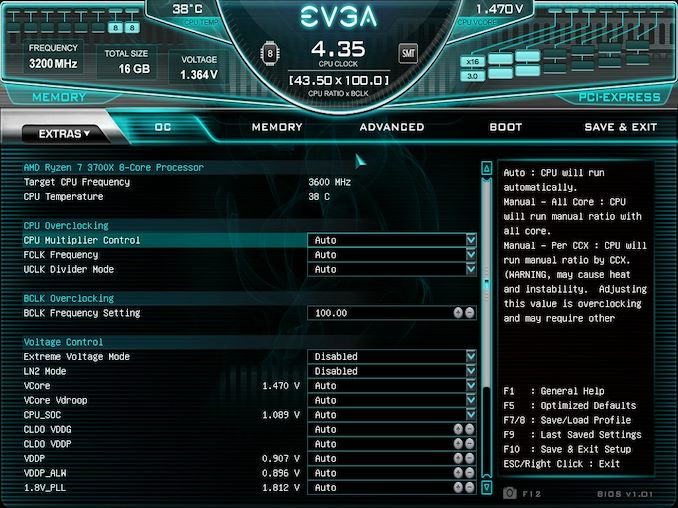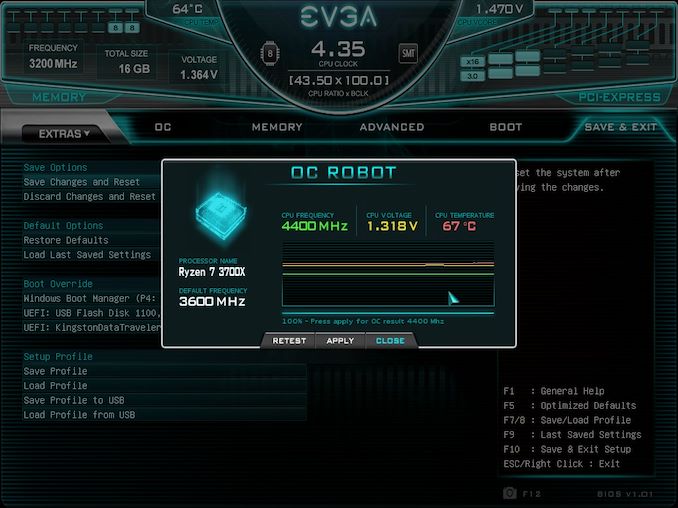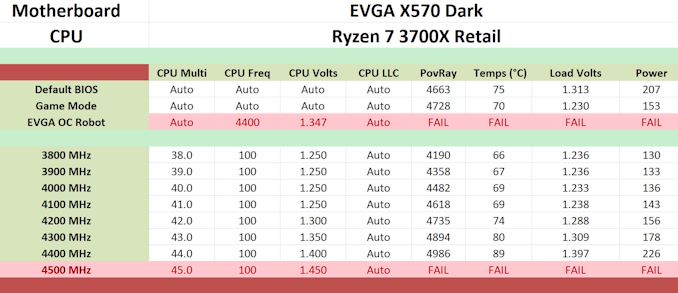The EVGA X570 Dark Motherboard Review: A Dark Beast For Ryzen
by Gavin Bonshor on October 8, 2021 8:00 AM ESTOverclocking Ryzen 3000
Experience with the EVGA X570 Dark
Despite AMD's Ryzen 5000's presence on the current market and support for these across various AM4 chipsets, we do all of our AM4 testing with the Ryzen 7 3700X processor for consistency. Overclocking can yield many benefits in performance, but at the drawback of extra heat and power. This is a consequence of adding more CPU VCore. (It should also be noted that right now I do not have a 5950X for motherboard testing, but as we've used this 3700X for so many AM4 boards in the past, we know its characteristics quite well - an overclocking motherboard should also be able to push other CPUs than just the flagships too).
Most power delivery is over-engineered to support the latest processors, however hot they run. This is a continuance of CPU vendors constantly pushing default and turbo clocks, pushing the silicon to its limits. Anyone looking to overclock will need to consider more aggressive cooling types such as hefty premium AIOs.
Focusing on the EVGA X570 Dark, it's full of options for users to overclock both the CPU and memory. Designed primarily for extreme overclocking, it has an LN2 mode which users can enable in the firmware. To overclock the processor, users can adjust the CPU multiplier, which controls the frequency in 0.25 increments. This is great for fine-tuning extra amounts of frequency where regular x100 MHz increments yield instability. There are also many voltage options for users to tweak, but general users should leave these on automatic as most of them relate to extreme overclocking. Users can push the voltage limits beyond the norm with the Extreme Voltage Mode option.
The memory section is also full of options for users to customize, with options including frequency, voltages, and latencies. Users can enable X.M.P 2.0 memory profiles on compatible memory kits, although EVGA does include some custom memory profiles for high bin memory, which Vince has tuned.
One of the more interesting overclocking options comes via the EVGA OC Robot. The OC Robot function allows users not confident in overclocking to let the firmware do the work. This includes stress testing at each frequency, which is likely done via a built-in lookup table based on specific parameters such as voltages. This kind of feature isn't new, but it's one for users looking to get a good baseline on what their processor is capable of without doing copious amounts of tweaking and stress testing.
Overclocking Methodology
Our standard overclocking methodology is as follows. We select the automatic overclock options and test for stability with POV-Ray and OCCT to simulate high-end workloads. These stability tests aim to catch any immediate causes for memory or CPU errors.
For manual overclocks, based on the information gathered from the previous testing, start off at a nominal voltage and CPU multiplier. The multiplier is increased until the stability tests are failed. The CPU voltage is increased gradually until the stability tests are passed. The process is repeated until the motherboard reduces the multiplier automatically (due to safety protocol) or the CPU temperature reaches a stupidly high level (105ºC+). Our testbed is not in a case, which should push overclocks higher with fresher (cooler) air.
We overclock with the Ryzen 7 3700X for consistency with our previous overclocking tests.
Overclocking Results
Overclocking is supposed to be EVGA's bread and butter with the Dark series, and our testing with the X570 Dark shows this to be very fruitful. There are two overclocking presets of sorts to select from, the Game Mode and the EVGA OC Robot. Testing both of them compared with the default settings, the Game Mode performed around what we would expect with an all-core overclock of 4.1 to 4.2 GHz level, but with lower CPU VCore and, ultimately, lower temperatures and power draw.
The EVGA OC Robot done its magic, and we ended up with a 4.4 GHz all-core overclock at 1.318 V. Knowing previously what our limits were with our chip, we did feel this was going to be too conservative to run with POV-Ray, and it was, as the overclock itself failed to complete the test. As we tested each 100 MHz increase, POV-Ray performance consistently went up as a result.
Interestingly, we managed to get an all-core overclock of 4.4 GHz at 1.400 V, which is the furthest we have managed on this chip. It's clear the EVGA X570 Dark has the edge over the more conventional X570 motherboards, but it showed its true colors and prowess in engineering to achieve this.













36 Comments
View All Comments
DigitalFreak - Sunday, October 10, 2021 - link
It's an e-peen board for the LN2 crowd and people with more money than sense, nothing more.Bavor - Tuesday, April 19, 2022 - link
If your priority is network transfer speeds, this motherboard isn't marketed toward you.iranterres - Friday, October 8, 2021 - link
2 RAM slots, 2 M2 slots,, lack of USBs 2 extra frames per second on average, 700$ = LOLmeacupla - Friday, October 8, 2021 - link
That's more on anandtech not using liquid nitrogen to cool the CPU for extreme overclocking, rather than the board costing $700 and "not delivering on performance".It's like putting an engine from a scooter into an F1 car. Of course it's going to underperform.
ballsystemlord - Friday, October 8, 2021 - link
The missing RAM slots greatly diminish it's appeal.For USB, you have headers which is fine IMHO. Everyone wants to access their USB ports from the front panel where it's more convenient anyway.
Considering AMD normally has a very low compression score, it'd be neat to know how they boosted it.
In general, the pricing on the current MB generations are through the roof.
I recall maybe a few year ago when MBs were $200 for the top end.
meacupla - Friday, October 8, 2021 - link
If you don't understand why it only has 2 RAM slots, this board is not for you.ballsystemlord - Friday, October 8, 2021 - link
Obviously. But why doesn't it have 4 RAM slots?Eliadbu - Friday, October 8, 2021 - link
More optimized memory traces paths, which will allow more stable memory over clocking. Normal users have no need for this but those who try to break world records, it may mean the difference between getting the top score or not. This is the idea of dark lineup - getting the the extra few percentages for those who are in the extreme and also make the process easier for them.Daeros - Saturday, October 9, 2021 - link
What does Wi-Fi or the second NIC add to the overclocking percentages?Eliadbu - Saturday, October 9, 2021 - link
Non, I guess users requested it so they added this alongside with RGB and other stuff . My X299 dark has doesn't have wifi card or